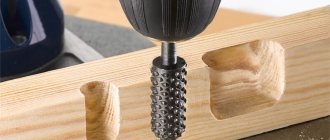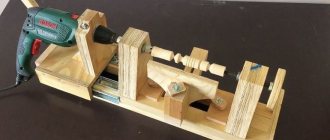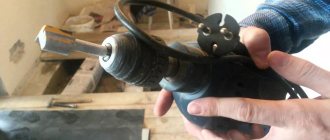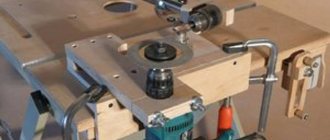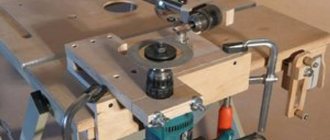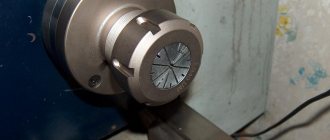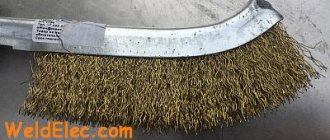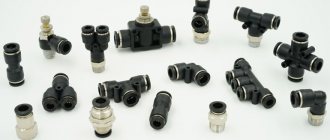The functionality of electrical appliances can be increased by connecting devices and various additional accessories. Thus, a wood cutter for a drill allows you to work with wood and cut shaped notches in timber. They achieve a high-quality level in roughing or finishing of blades by installing working attachments with an actuator.
Wood cutter for drill
Manufacturers have produced various types of cutting elements, but they need to be selected correctly; they must be suitable for working with a specific drill.
general information
The drill cutter is one of the replaceable elements. Each part in the assembly performs an important function. The motor of the electrical appliance transmits the rotation speed to the shaft, and the nozzle with accessories will rotate with it.
Milling cutter
Only the cutter processes a given area. The final result depends on the correct choice of which, combination of parameters, compliance with conditions.
How the cutting part works
Actuating mechanism
The actuator consists of 2 elements:
- shank (1) – it is clamped by a cartridge to transmit torque;
- working sphere (2) – there are sharpened blades on the sides of the head.
The configuration of the cutting edge provides different capabilities to this knife. The quality and type of sharpening are used to perform tasks of varying complexity. An additional element - a support bearing (3) - can simplify milling with a drill or expand these functions. For example, process a workpiece according to a template. If the system is dismountable, the cutter with its constituent parts regulate the work processes in the desired direction using:
- locking couplings;
- calibration bushings;
- washers;
- screws
The shank or base of the cutter comes in different lengths and diameters. These parameters are taken into account when choosing.
The chuck must hold the part tenaciously and be long enough to perform specific operations. The technical characteristics and purpose of the blade determine how much work can be done with it. It is sharpened manually and using high-precision equipment if there are no backlashes in the structural elements. In addition to sharpening, the alloy from which the item is made is also important. The hardness level of the steel must correspond to the structure being processed, in this case wood.
The standard set of cutters includes elements of different parameters and categories in the form:
- mounted, when the landing part with a diameter of 32 mm can only be installed in stationary milling equipment;
- end with a shank from 8 to 12 mm. in diameter, they are mounted on the machine shaft and on the drill.
This assembly replaces a professional milling cutter when processing:
- natural wood;
- plywood;
- chipboard;
- MDF.
When the cutting tool is going to process plywood, a knife with a high level of wear resistance is inserted. Let's say that a jigsaw with its cutting plates contains a strong alloy and is not sharpened.
Application at work
The main problem limiting the use of a drill when milling is ergonomics. The entire design of the power tool is aimed at processing the material along the axis of rotation. When milling, movements directed perpendicularly are required. In most cases, it is impossible to ensure positioning of the drill, especially when holding it with one hand. Therefore, the lot of owners of only one tool remains drilling and light types of work, such as grinding edges.
A good way out of this situation is to use special devices similar to those used in woodworking routers. Today you can find various options for drill attachments in the form of a support table, a sliding base or a vertical bed. If these are not available, it is enough to secure the electric drill to the table using clamps. After this, all that remains is to install the cutter for the drill and you can start milling.
Household electrical appliances are not designed to perform heavy-duty operations, so using a drill for metalworking is unlikely to work. In some cases, it can be used to cut sheet material or correct an edge. A much wider range of work is provided when processing wood. If high productivity is not required, then almost all types of milling operations can be performed. The same can be said about plastic work. A certain disadvantage in both cases will be the difficulty of selecting modes, since not all drills will provide the required tool rotation speed. You should also pay attention to the engine power of the power tool. In budget models, this parameter can significantly limit the diameter of the equipment used.
What do they pay attention to?
If you use a drill for milling wood, take into account a number of features:
- The operation of bearings on a shaft with the calculation of axial longitudinal load. In some types of mechanisms, a lateral force is applied, which affects the rapid wear of parts.
- Speed of revolutions.
- Cooling methods.
- Engine power.
- Handle placement.
- Cartridge quality.
Electric drill cutters
The electrical device must be equipped with a function that regulates speed with a large reserve of power - this means that cutters for an electric drill can be installed on it.
If there is incompatibility in the mechanism of devices, negative consequences are possible:
- the tool will overheat;
- the gearbox will fail;
- in the process, a distortion of the workpiece is formed;
- the shank will pop out due to an unreliable cartridge.
There are unwritten rules for milling:
- actions are performed slowly, accurately and accurately;
- check all connections, electrical wiring, fixation;
- Allow the drill to cool periodically.
When large volumes of work are to be done, a carbide nozzle is needed. Only after the equipment is securely fixed in the chuck do they begin to mill.
Choose a knife according to the following criteria:
- size - the parameter affects the assigned technological task;
- shape, configuration, location of the blades;
- sharpening angle;
- manufacturing materials - the performance of various operations and service life depend on the steel;
- purpose - if the milling drill is durable, it is used not only for wood drilling, but also for harder materials.
When buying any product, they visually evaluate it and look at the manufacturer’s company. The reputation of the enterprise will reveal the pros and cons of production. You need to do the same with the equipment. If the buyer is not rich enough to afford a cheap thing, the cutter should be of good quality and expensive.
Selection options
When choosing one or another method of milling wood, first of all you should pay attention to the possibility of installing a milling attachment on a drill. To do this, the power tool must have a cylindrical neck, in the extension of which a chuck is installed. In the absence of one, it is not recommended to use a specific drill model for milling. If it is installed on a specialized drill device intended for milling, then you can select cutters. First of all, you should pay attention to the type of work. The milling tool is not universal, so each operation will require its own model of equipment. The diameter of the shank must allow clamping in a specific drill chuck. It is not recommended to use large cutters, as they can require significant spindle power.
It is also necessary to take into account processing modes. Many wood tools require high RPMs that are unattainable with drills. It should be remembered that any electric drill is not designed for long-term loads. Therefore, it is not recommended to apply great effort to it and perform work continuously for a long time.
Design Features
The cutting device is based on the teeth around its body and the manufacturing technology of the structure itself:
- solid - made of one metal composition;
- combined - with knives made of one hard alloy and a body made of another metal;
- welded, when the shank is connected to the blades by welding;
- soldered - the assembly is fixed by soldering.
The blades can be pointed with a front and back flat surface. The disadvantage of such items is that they are sharpened; they shrink in size, so they are not suitable for reusable use. Unlike backed bits, which can be resharpened. On the front side they are flat, and on the back they are twisted like an Archimedean spiral. Such a profile is obtained by uniform movements - translational and rotational. The backing procedure is performed with cams, which creates a stable back angle along the entire length. A similar design is created for cutters:
- shaped;
- worm;
- modular.
Cylindrical peeling knife
The mounted cylindrical peeling knife has separation grooves for chips.
They are directed in one direction, and the backed tooth is directed in the opposite direction. Blades placed in different directions allow high-quality processing of side walls. They are pressed into the body, where the radial corrugations move. After sharpening, the dimensions of the actuator do not change.
Basic actions and their order
Wood is a soft raw material. Different types of cutting tools have been developed for its processing. When choosing equipment you need to consider:
- The wood cutting knife should not be used for grinding or cutting metal structures.
- The drill for metals is made of strong high-alloy compounds that cannot negatively affect the operation with chipboard. There will be no overheating of the motor and gearbox. The end blade has this design; it is used to cut sheet material, and small-sized groove milling is performed. Although such models are endowed with a small number of feathers.
Groove cutter with different geometries, convenient for creating long grooves. And shaped cutters are used only for tortuous, complex design configurations.
Edge knife
The edge knife itself speaks about its purpose; it is good for sanding the sides. A bearing is installed at the end of such blades; it regulates the direction and prevents it from moving away from the formation of the edge. Finishing is performed on both straight and shaped edges.
Repairs to wooden buildings are not complete without sealing old holes and cutting out new ones.
Actuator of different designs
This requires a drill, and to perform several tasks you will need a whole set.
Where each tool has its own dimensions in diameter and length. They have the peculiarity of changing proportionally. When one value increases or decreases, another indicator changes in the same direction. There are no thin and long elements; they will simply break under a slight load. For example, at 12 mm. diameter, the length will be a drill bit for a drill of 50 mm., There are also 60 mm. These devices are also different in appearance:
- spiral;
- screw;
- feathers;
- ring;
- countersinks;
- flexible.
Through space can be created, different in geometric shape:
- cylindrical;
- conical;
- stepped;
- square.
The mechanism for wood processing, unlike metal processing, has a conical end; it is used to mark the drilling location.
Types of cutters by material processing method
Finally, we move on to considering the variety of cutters, which allows us to select equipment for certain types of work with wooden workpieces.
End mills
Such cutters can, in principle, be classified simply as groove cutters, but they are distinguished from the general background for their similarity to a conventional drill. In fact, they were just discussed when talking about equipment with a spiral arrangement of cutting edges. And an illustration that clearly shows the structure of such cutters is already posted above.
End mills have a sharpening of the end part that differs from a conventional drill, but this does not prevent them from plunging well vertically into the material being processed. And the hole obtained with their help gets an almost flat bottom.
Example of end mills and their capabilities
But drilling holes is just one of the functions of end mills, which have considerable versatility. Spiral edges ensure high-quality sampling of material even during horizontal movement of the tool. As a result, this allows you to cut grooves, for example, for installing locks, for tongue-and-groove joints of parts, select quarters, process the ends of workpieces, etc.
In a word, end mills in skillful hands become quite multifunctional equipment. By the way, many of them are often used, in the absence of a hand router, with an electric drill - for example, when cutting grooves for locks.
With some degree of convention, the so-called burrs, which are often called cutters, are also classified as end cutters. This is a rather unique piece of equipment, sharply different in appearance from other attachments.
Burrs or cutters
Using roller cutters, you can give holes or the edges of cut grooves a certain configuration and fine-tune them. They are also used for decorative design of planes - for a kind of “engraving” on wood.
Slot cutters
The functionality is clear from the name. Such cutters are usually used to select grooves for various purposes, both for creating connecting parts of parts and for, for example, decorative design of products.
The grooves can be selected either from the edge of the part to its middle, or anywhere on the plane - the sharpening of most groove cutters allows vertical immersion of the cutting part into the material (although, unlike end cutters, this function is not prevalent).
The entire large group of groove cutters can be divided into several subgroups
Groove straight, fillet and fillet V-shaped
| One of the simplest cutters is a straight groove cutter. It is often referred to in everyday life as “finger”. The selection is similar to cylindrical plunge-cut end mills. After the passage, it forms a groove of a specified width with a perpendicular arrangement of walls and bottom. It may differ in the width of the selected groove and the depth of the cut (the length of the working part of the cutter). If necessary, the width of the groove can be increased by additional passes with the tool offset to the required distance. | |
| A groove fillet cutter selects a groove with a rounded bottom (fillet). Depending on the depth of immersion, the walls of the groove can be an arc up to 180 degrees, or initially have a section perpendicular to the surface with subsequent rounding. The cutter is often used for decorative design of products. | |
| V-shaped fillet. Unlike a regular fillet, it has a pointed tip and selects a groove with a downward angle, similar to the Latin letter V. Its application is similar to that discussed above. The width of the groove and the angle at the apex may vary. |
Slotted structural
| A cutter for making a dovetail groove - one of the most reliable connections of wooden parts. | |
| A cutter for making a T-shaped groove, often used as a guide for moving moving parts. Can also be used to cut out hidden loops for hanging items on the wall. | |
| A cutter similar to the previous one, but selecting a hidden trapezoidal groove. |
Grooved shaped
These cutters are available in a wide variety - they allow you to choose cuts of complex symmetrical shapes. In addition, they can, if necessary, process the end edges of the workpiece.
Very often, if these cutters are used for decorating surfaces, they are used after passing with a straight groove cutter. Because otherwise the cutting edges are subjected to too much load, leading to rapid failure.
Examples of common shaped phase cutters are shown in the table:
Edge cutters
This is a very large group, which can also, with some degree of convention, be divided into several subgroups. A distinctive feature of most edge cutters is the presence of support bearings. This makes it possible to process the end sides of workpieces not only using the guides of the milling table, but also using templates, including complex curved shapes.
Edge straight
The cutters are designed to produce smooth edges perpendicular to the planes of the workpiece. The support bearing can be located at the bottom or at the top. The diameter of the bearing can be equal to the diameter of the cutter, but others are also used, larger or smaller, which even somewhat expands the capabilities of the equipment, for example, for proportionally increasing or decreasing parts relative to the template.
Edge molding
Milling cutters make it possible to give the end sides of the workpiece a convex or, conversely, concave, rounded or wavy shape of various configurations. Widely used for finishing workpieces to give them decorative qualities. They can also be used to create complex artistic ornaments.
Edge molding also includes a cutter that rounds the end of a workpiece on both sides in one pass, for example, when making a table top. Such cutters often provide the ability to change the distance between the upper and lower cutting edges, located symmetrically.
Prices for a set of cutters “STAYER”
cutter set “STAYER”
Composite edge molding cutter (attached) – the craftsman is given the opportunity to change the distance between the cutting edges depending on the thickness of the workpiece.
Edge rebate cutters
Designed for making rectangular grooves along the ends of the workpiece or for cutting quarters. If two passes are used, that is, on both sides of the workpiece, then a straight tenon is formed in this way.
Seam edge cutter
Often, such cutters are equipped with a whole set of support bearings of various diameters. This greatly simplifies the selection of grooves of different depths.
Edge half-rod
By processing with such a cutter, a semicircular profile is formed at the end of the workpiece. But its use is not limited to this. For example, when used together with a fillet cutter, you can create a hinged connection of parts. Besides. A double pass on both sides of the narrow piece allows the wood core to be formed.
Edge fillets
A rounded groove (fillet) or chamfers rounded inward are formed at the end of the workpiece. As already mentioned, when used together with half-rod cutters of the same diameter, they provide the opportunity to create hinged joints.
A fillet end mill is often equipped with two support bearings located at the top and bottom. This way it is possible to avoid distortions when making a groove.
Edge taper cutters
It is clear from the name that when the cutter rotates, its cutting edges describe a cone, and sometimes even two with an opposing or divergent angle. This type of processing is often used to precisely fit parts when joining them into a large-area panel. It can also be used to form chamfers or recesses of non-standard shape. The angle of the blades may vary.
Edge curly
This is the largest subgroup of edge cutters. Such equipment opens up wide possibilities for giving the ends of workpieces a wide variety of shapes, including quite intricate configurations.
Such cutters are usually quite large in size, very heavy, and not any handheld router can handle working with them. They are designed for professional-class equipment with a power of at least one and a half kilowatts.
You can sample along the entire plane of the workpiece, that is, using the entire length of the cutting edge of the cutter, or using only certain sections of the equipment. This expands the possibilities even further, which is why, incorrectly, such cutters are often called multi-profile.
Their variety is very wide, and not all models are presented in the table below as an example.
Combination cutters
The purpose of combined cutters is to form “locking” profiles for connecting wooden parts. For example, this is the installation of frames when connecting blanks at the corners, or gluing panels from individual boards (lamellas) - in this case, the locking profiles are cut along the entire length of the end part. This approach allows you to very accurately fit the parts to one another, as well as significantly increase the contact area, which is extremely important for high-quality gluing.
Some cutters from this group are used to create dismountable tongue-and-groove joints, for example, for lining or tongue-and-groove boards.
Here, too, several subgroups can be distinguished.
Tongue and groove cutters
The name itself speaks about its purpose.
This can be a set of two cutters, each of which is “responsible” for its own section - one creates a groove on one side of the board, the second creates a tenon on the opposite side. This use allows you to do without precise adjustment, since the cutters in the kit are already perfectly aligned according to their “mutual geometry.”
A set of two cutters designed to create a tongue-and-groove joint. It is convenient, for example, to quickly prepare tongue and groove boards.
Another option: a set-mounted cutter, which in one position will select a groove, and in another, with the installation of two cutting heads, will form a tenon.
And this cutter can be “reset” either for cutting tenons or for making grooves.
Another representative of this subgroup can be considered a set of two cutters for preparing lining. As they pass, the cutting edges not only form grooves and tenons, but at the same time also remove chamfers that are characteristic of lining.
Set of cutters for self-production of lining
Combined frame cutters
As a rule, these are mounted (set-up) cutters, which provide the master with the opportunity to change the relative position of the cutting edges and the distance between them. Often it is even a set of two cutters of this type.
By the way, reassembly of such cutters can be carried out even without removing the shank from the collet of the router - this allows you not to disturb the set position. It is enough to unscrew the locking screw and change the arrangement of the cutting heads, separating couplings, bearings, and then secure the assembly with the screw.
Several examples of frame combination cutters are in the table below:
Combined universal cutters
Another subgroup of tongue-and-groove combination cutters, original in design and very easy to use. The fact is that by changing the position of the cutter, you can form edges in one pass that are strictly inversely symmetrical to each other. That is, when the parts are rotated 180 degrees, they ideally fit together at the edges, becoming completely ready for assembly into a single structure.
A few typical examples of such universal cutters and the edges they create are in the table below:
The illustration below shows the principle of using one of these universal combination cutters.
Processing edges with such a universal cutter allows you to make frame joints (at an angle of 90 degrees)
Figurine cutters
Figurine cutters are usually used for the manufacture of large parts that require either precise adjustment for assembly, or/and a complex external configuration. Typical examples are panels for doors or furniture, wooden baseboards, decorative strips and other similar interior details.
As a rule, cutters have very impressive dimensions and weight, so they should only be used with powerful cutters, at least 1500 W.
Figurine horizontal cutters
Designed to form the edge of the panel. It should be noted right away that the edge of the panel cannot be obtained in one pass - additional processing of the tenon on the opposite side is required.
A few examples are in the table:
Curly double-sided horizontal
These are usually attachment cutters that allow one pass to both form the face of the panel and cut a tenon for inserting the frame grooves. The cost is certainly higher, but the productivity also doubles.
How to prepare a drill for milling
Electric drill
It may not be possible to open a full-fledged carpentry business with an electric drill, but in a home workshop, various milling procedures are often simply necessary.
Reconstruction begins from the place where the electric motor will be mounted.
If you don’t have an old table, you can put it together from available materials - boards, plywood. Bars are suitable for support legs. A recess is made on the countertop for installing the device with guides. You will need to cut a semicircular groove with a saw and drill through the circles to attach the support sheet.
After building the table you will need:
- electrical appliance;
- small cutter for testing;
- cartridge;
- chipboard sheets.
The drill is secured with clamps to a chipboard stand. The cutter is installed on the shaft. The elevator will be the carriage of the power tool with the main body. The stand and the limiting platform are connected at a right angle. The knife should extend beyond the base.
Edge sharpening
The set of equipment is not thrown away after long use; if corrected, they retain their normal condition. This is how a shaped end mill is sharpened along the front cutting edge with a diamond stone. It is attached to the table and the blade is moved along it. The sharpener is moistened with soapy water. The pointed areas will gradually recover with minimal loss in diameter.
If there is a guide bearing, remove it first, then start sharpening. Before work, first clean the cutter with a solvent to remove any remaining wood resins. The sharpening stone is chosen of the correct shape according to the level of grain. It depends on the thickness of the layer being removed and the degree of surface grinding.
They sharpen each tooth in turn, maintaining symmetry with the same number of movements, pressures - in the same direction. For soft cutters, use ordinary sandpaper, abrasive paper, which is glued to a steel or wooden strip.
Grinder
If you have a sharpening machine, then manual work can be replaced with mechanical work. The tip is restored to its former state all around, material is used for it:
- white or normal electrocorundum;
- elbor;
- green silicon carbide.
The machine can sharpen even the most complex spiral tooth shapes using rotational and translational movements. The cutter, during its longitudinal movement towards the circle, makes synchronized turns along the axis. The position of the edge does not change in height, and contact with the abrasive is maintained along with the sharpening angle.
At the end of the procedure, a control inspection of the blade is made for chips and cracks. A special device is used to determine the deformation for runout and the absence of changes in the angles. A deviation of 1 degree is allowed. Good care and correct editing will extend the life of cutters and main power tools.
Summary
Article Name
Wood cutter
Description
Wood cutter for drill 35 mm, 50 mm, 100 mm. Wood end mill for drill. Do-it-yourself wood cutter from a drill.
Author
Sarychev Alexander Viktorovich - forensic construction and technical expert, candidate of technical sciences
Publisher Name
Wikipedia of construction tools
Publisher Logo
- Related Posts
- Drill attachment for sharpening drills - review, how to choose
- Drill: design, types, how to choose, repair and use? The best electric drills of 2022
- How to remove the chuck from a drill - detailed instructions
« Previous entry
Do-it-yourself vertical milling cutter
It is quite difficult to operate a drill with such an attachment installed in its chuck, and it is almost impossible to obtain a clean result. If you don’t have a milling machine at hand, but you need to use a milling attachment to do rough work, then a regular drill will do. To do this, it is recommended to fix it in a vertical position and securely fasten it.
This is interesting! To be able to regulate the rotation speed of the tool chuck, it is recommended to use a voltage regulator.
Homemade milling machine
In order to rough-process wood, you will need an appropriate set of wood cutters, as well as a homemade machine from a drill, which you can make with your own hands. Manufacturing the installation does not require any skills or knowledge, and in each individual case the design may differ. The main rule of such an installation is to securely secure the tool.
To make a homemade milling machine from a drill with your own hands, you will need to perform the following steps:
- A table is being made, which requires wood. The amount of wood required to make a table depends on the size of the future device
- Creating a platform with a limiter. The drill will be fixed in this area and moved using the appropriate guides. To make the platform, you can use chipboard and steel tubes
- Installing the tool on the platform. To secure the tool, you need to use steel plates and threaded connectors in the form of bolts and nuts
- Making a handle that moves the tool vertically up and down
Homemade machine for milling wood
The drill milling machine is ready for work. You can install the appropriate cutters in the chuck and begin testing it. Do not forget that the work must be carried out with extreme caution, since the slightest wrong movement can cause the tool to be torn out from the installation structure.
If the device you built yourself passes the first test, then you can make a control panel for it to make it easier to operate. Such a tool has one significant advantage - it can be used for both milling and drilling. The drill can be removed at any time and used outside the structure. Do not forget about the negative impact on the drill when working with attachments, which greatly reduces the service life of the tool.
